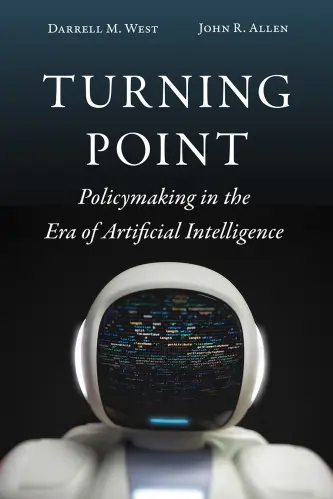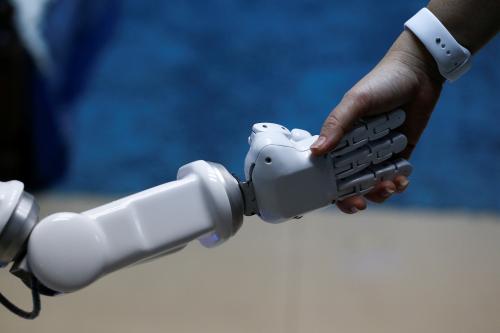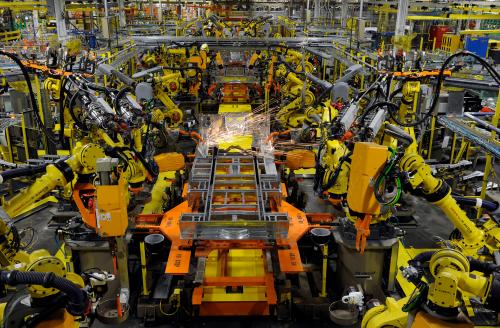As digital technology accelerates, there are questions about who is most likely to lose jobs due to automation and what the overall future of the US economy looks like. These questions are worth asking—particularly after a pandemic that appears to have hastened the automation of many tasks in American industries. Yet research on automation has so far centered almost entirely on the presence of digitalization, automation-potential estimates, the relationship between technological change and macroeconomic conditions, and tech’s impact on inequality and wage divergence.
Since technological change often is quite disruptive and spurs economic and political shocks, it is vital for researchers to study the attitudes of the individuals most vulnerable to new technological shifts. In doing so, researchers can gain a humanizing window into how these shifts—so crucial to capitalism’s advancement—are borne out in the beliefs, characteristics, and fears of the individuals most likely to experience disruption due to automation
The results of my work offer an ominous window into how technological change may correspond with despair, radicalization, and democratic erosion. This study shows that the Americans whose occupations have the highest automation potential tend to have a dark and cynical view of politics, the economy, the media, and humanity. They comprise a traditional working class that is politically left-leaning on economic issues and slightly right-leaning on socio-cultural ones. Although they are moderately more likely to support Democrats, they are increasingly likely to support Republicans since 2000. These often-economically-vulnerable Americans are deeply pessimistic about the state of the world and politics; they also have a tendency to vote against their economic interests and become more authoritarian in their outlook.
Technological Change Often Causes More Inequality
My work examines studies on the relationship between economic upheaval and radicalization, polarization, and revolution. In addition, I look at how technological change impacts inequality, wage divergence, and job polarization. Works from David Autor, Robert Allen, and Daron Acemoglu, in particular, have been able to illustrate the ways that digitalization can catalyze labor substitution, the erosion of the middle class, and greater income inequality.
It seems clear that technological advancement can both stifle real wage growth for many workers while simultaneously increasing returns to capital by making labor more productive. This tends to benefit the owners of productive capital and some workers whose skills are complemented by the new technology. Moreover, when productivity tends to rise faster than wages, inequality increases almost by definition since new GDP gains accrue primarily amongst capital owners, rather than workers. Technological change can additionally lead to a hollowing out of middle-wage work, in turn producing a smaller middle class. Digitalization appears to be inducing dis-equalizing shifts through all of these mechanisms.
Americans Susceptible to Automation Have a Dim View of the World
My study merges American National Election Survey data from 1990-2016 alongside the automation-potential estimates that are produced by McKinsey and presented by Mark Muro in a 2019 report. Due to the considerable size of this dataset, I utilized 11 indexed variables to proxy for specific general characteristics (see Figure 1). I then looked at the relationship between the automation potential of an occupation and the beliefs of workers—for example, if a person believes the minimum wage should be increased or lowered.
First, I look at the demographic characteristics of the Americans most susceptible to automation.
Table 1: Demographic Summary Statistics
| Demographic | Total (n = 26,311) | Percent High Automation Potential | |
|---|---|---|---|
| Race | White | 18,129 | 63.03% |
| Black | 3,587 | 75.05% | |
| Asian | 470 | 72.34% | |
| Hispanic | 3,150 | 78.34% | |
| Gender | Male | 12,083 | 66.41% |
| Female | 14,156 | 67.79% | |
| Income | Lowest Third of Income | 8,091 | 72.22% |
| Education | 9-12 Grades | 2,243 | 75.61% |
| BA Degree | 4,825 | 61.93% | |
Table 1 clearly demonstrates that Hispanic individuals—followed by Black and Asian individuals—are more likely to work in jobs with the highest automation potential; women, too, are slightly more likely to fall into the high automation pool. This corroborates Mark Muro’s 2019 findings. Beyond this, the automation potential of the average worker tends to be higher in the South, among the lowest third of the income distribution, and generally among people with less education.
Yet what are the beliefs of these automation-susceptible individuals? In Graph 1, I look specifically at this question by offering a brief portrait of the views that the Americans most susceptible to automation are likely to hold.
As the model shows, Americans who work in an occupation that has a high susceptibility to automation tend to be less politically engaged, less supportive of the media, and more pessimistic about the nature of politics and the power of their voice. Although highly automation-susceptible individuals show a slight preference for Democrats, this preference is waning; in the years since 2000, it has fallen below the average support for Democrats amongst the broader US voter population. This indicates a possible shift away from the Democratic Party in the last two decades, as both political apathy and engagement have worsened.
Moreover, Americans with a high susceptibility to automation since 2000 also are nearly 5 percentage points more likely to express racist, antisemitic, homophobic, or sexist attitudes. This increase in intolerance is even more pronounced when isolating for more specific categories of racial animus; although many of the same individuals who hold racist views of Hispanics will also hold racist views of Black Americans, for example, this is not necessarily always true. The 5 percent figure thus underrepresents the relative increase in intolerance amongst automation-susceptible individuals.
Beyond this, Americans whose jobs are highly susceptible to automation are less supportive of globalization and immigration; however, they hold more left-wing economic views on average than the median working American. Automation-susceptible individuals also tend to be slightly more culturally conservative since the 2000s. Finally, highly automation-susceptible individuals are more likely to have a cynical view of human nature (e.g., believing people are fundamentally dishonest) and to express authoritarian tendencies—valuing obedience, for instance, over individuality and expression. In Table 2, I offer a breakdown of these results between different demographics of Americans.
Table 2: Difference in Means of High & Low Automation Groups
| Index Variable | All Observations | Black | Hispanic | White | Post-2000 |
|
Political Affiliation |
+4.42% | +2.67% | +2.69% | -.73% | -1.11% |
| Political Engagement | -5.39% | -5.12% | -8.26% | -4.08% | -8.77% |
| Political Optimism | -6.65% | +15.63% | -2.62% | -9.54% | -12.65% |
| Support for Media | -15.8% | -18.40% | -11.11% | -15.30% | -14.44% |
| Left-Wing Economic Views | +7.36% | +3.82% | +2.08% | +2.76% | +1.50% |
| Globalism | -8.02% | +13.08% | -9.08% | -12.10% | -8.04% |
| Culturally Liberal | -1.84% | +2.10% | -4.46% | -1.95% | -0.30% |
| Individualism or Obedience | -25.10% | -26.17% | -35.76% | -17.89% | -23.89% |
Some key findings here are that white Americans with a high automation potential diverge from other racial groups in their slight preference for Republican candidates and conservatives over Democratic candidates and liberals. White Americans whose jobs are highly susceptible to automation are also more likely to have a grim view of their lives and to be opponents of immigration and international trade than whites who are not as vulnerable to automation. Highly automation susceptible individuals of all demographics, however, are more likely to hold authoritarian views than low automation susceptibility groups.
The Evolving Worldview of America’s Working Class
My results point to three important trends in American politics and the economy. The first is that automation-susceptible individuals are indeed a demographic category with a sufficiently unique set of beliefs and characteristics. Second, individuals highly susceptible to automation are more likely to hold progressive economic beliefs, in line with their interests. Finally, highly susceptible individuals are becoming more despairing and more likely to vote for Republicans and against a progressive economic agenda.
One possible explanation for this is that the demographic most likely to be harmed by technological-change-induced labor shocks are increasingly voting based on cultural, rather than economic, issues. If this thesis is true, it would corroborate the notion that a distinct portion of the American working class has shifted away from the Democratic Party as the cultural wars came to dominate public debates. My results thus suggest that a combination of progressive economic and conservative cultural policies may prove most attractive to Americans whose jobs are highly susceptible to automation.
The Brookings Institution is committed to quality, independence, and impact.
We are supported by a diverse array of funders. In line with our values and policies, each Brookings publication represents the sole views of its author(s).








Commentary
Automation and the radicalization of America
November 22, 2021